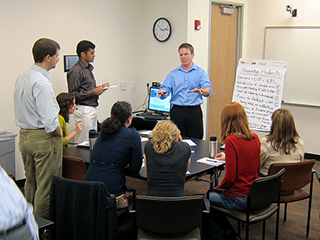 Write an analytical report that explains everything that goes into writing a specific kind of writing that you will do in your career. To find out how the kind of writing works, you will find online resources, interview people in the field, and analyze examples.
Write an analytical report that explains everything that goes into writing a specific kind of writing that you will do in your career. To find out how the kind of writing works, you will find online resources, interview people in the field, and analyze examples.
Think of your audience for this project as yourself. Your goal is to learn about the characteristics of a specific kind of writing you will typically do in the workplace. While you will probably not complete such a thorough examination of the kinds of writing you do when you are in the workplace, the skills you develop during this project will be ones you can return to whenever you are faced with a kind of writing that you are not familiar with.
The Project Assignment
Step 1: Review the feedback on your proposal and make any necessary adjustments.
While you are waiting for my feedback, go ahead and start your report. Once I return your Short Report Proposal, review my feedback and make any adjustments to your plans that are necessary. I have never had to reject a proposal, but I do ask for changes to plans occasionally.
Step 2: Familiarize yourself with the characteristics and features of reports.
The following chapters from online textbooks offer advice on writing reports:
Similar Project Examples by Students
- Technical Reports from Style for Students Online: Effective Technical Writing in the Information Age
- 9.4 Report from Business Communication for Success
- Articles from the “Professional Business and Technical Writing” section of Writing Commons
If you like video tutorials, these Lynda.com course materials (free login with your Virginia Tech pid and password) can help you:
- Learning to Write Technical Reports (2hr 30m)
- Writing a Business Report (1hr 58m)
If you need help with documentation for the sources you use, read Chapter 5. Using Sources from Style for Students Online: Effective Technical Writing in the Information Age.
This information will help with the layout and design of your reports:
- Document Design from Technical Writing
Step 3: Complete your research on the genre you have chosen.
Reflect on your knowledge of the genre, considering the examples you have seen and what you know about the genre’s importance in your field. Once you establish what you already know, conduct the following research to learn more about the genre:
- A literature review and evaluation of online resources
Find out what have other researchers and practitioners have found out about the particular genre in question. Check the course textbooks as well as any resources you own or have access to. Search online for additional resources and note the information and advice you find. - Interviews with people who actually write and read these documents
Ask people who read the genre what they expect to find and how they judge the quality of the works. Ask people who write the genre how they prepare to write, what they include in the genre when they write, and how they make decisions about the genre.
- Site inspection
Examine the actual physical work environment or conditions where people who write the genre complete their work. Think about where they gather the information needed to compose, where they complete their composing, and how they share the genre when they are done.
Step 4: Write your Genre Analysis Report.
 Create your project in your word processor. With examples and relevant formatting, your report will likely be close to 15 pages long, though there is not a minimum or maximum page length. Write as much as you need to, but be sure to include all of the required information.
Create your project in your word processor. With examples and relevant formatting, your report will likely be close to 15 pages long, though there is not a minimum or maximum page length. Write as much as you need to, but be sure to include all of the required information.
Your report should include the following sections:
- cover page (be sure to list your name as the author)
- executive summary (or abstract)
- table of contents
- introduction
- methods
- results (or findings)
- conclusions
- references (your sources and documentation)
- appendix (where your full examples of the genre go)
You can include additional sections and information, and you can change the headings to fit your analysis. Use the example genre analysis reports (listed above) to make decisions about how to vary the organization.
Be sure that the body of your report covers this information:
- The purpose for your particular genre—that is, you will identify and explain the situation that creates the need for this particular form of written communication, the purpose and occasion that calls this kind of writing into being, or the work that needs to be done and to which this text responds.
- The audience or users of this particular genre, including their knowledge, experience, and work environments, their motivations for working with the genre in question, how they perceive and use the text in question, and what they do with it.
- The constraints at work on the writers and the readers of these documents, including computing environments, documents, facts, and workplace objects, but also less tangible factors such as relations, beliefs, attitudes, traditions, images, interests, and motives that are in play in their organizations or workplaces.
- The preparation needed to write the genre, including how you would gather data and the research you do would do.
- The organization of the genre, detailing the typical order for the document, any possible variation of the order, and any additional sections that may be added.
- The contents of all sections of the kind of writing, describing the kind of information included in each of the sections.
- The ethical and/or intercultural and global issues that may impact the kind of writing.
- A bibliography that provides documentation for all of the resources you have consulted. You may use whatever bibliographical format you are most familiar with. Here are some tools if you are unsure what to use:
- EasyBib online citation builder creates MLA-format for free.
- Son of Citation Machine creates MLA, APA, and Chicago citations for free.
- Cite This For Me creates several styles, including IEEE, for free.
- At least three examples of the particular genre in question and analyze them to extract the generic conventions, characteristics, features, and strategies that distinguish this genre. In the case of longer genres, you can link to the examples.
Step 5. Review your project for design and basic writing errors.
Everything you write should use accurate/appropriate image editing, grammar, spelling, punctuation, mechanics, linking, and formatting. These are important basic writing skills that you should have developed in high school.
Also review your project, considering its layout and design. Refer to the details on the course website listed in the Ten Ways to Improve Your Writing and the grammar and design Lynda.com videos included on that page.
Step 6: Submit your project in Canvas.
Upload your project in Canvas.
Photo Credit: 20130806-FS-LSC-0186 and 20120814-OSEC-LSC-0043, both by U.S. Department of Agriculture on Flickr, used under Public Domain.
 Your group will collaborate to compose a guide to writing in the workplace. Each of you will profile a specific kind of writing, explaining everything that goes into producing the document. Your group will assemble all of these profiles into your guide, which you can publish in several ways. See more about publishing options in
Your group will collaborate to compose a guide to writing in the workplace. Each of you will profile a specific kind of writing, explaining everything that goes into producing the document. Your group will assemble all of these profiles into your guide, which you can publish in several ways. See more about publishing options in 
 A summary/description that introduces the entire series
A summary/description that introduces the entire series You will survey the kinds of writing people in your intended career field do and arrange the information in a table (like a benchmarking or comparison table). You’ll provide a short description of the different kinds of writing, identify the typical audiences and purposes, and classify the kinds of writing, matching the items to example resources online.
You will survey the kinds of writing people in your intended career field do and arrange the information in a table (like a benchmarking or comparison table). You’ll provide a short description of the different kinds of writing, identify the typical audiences and purposes, and classify the kinds of writing, matching the items to example resources online.